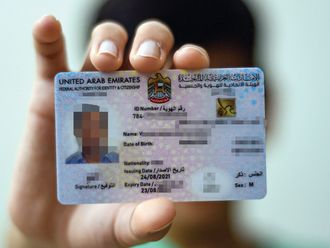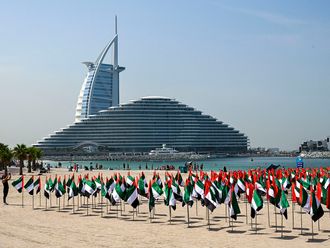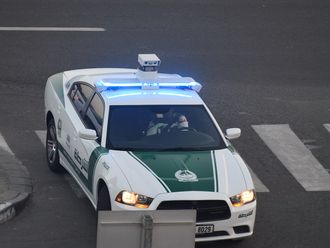
Dubai: National events in the UAE are celebrated by Emiratis and expatriates in the country with equal fervour. Whether it is the UAE National Day, Flag Day or any other national celebration, you can often see members of the public waving the UAE flag with pride. Many homes also adorn the flag over their balconies or windows. However, it is essential to know the etiquette of handling the UAE flag, as any act of misuse or disrespect can be strictly penalised.
Last year, on November 9, the UAE Public Prosecution published an awareness message on its social media channels, informing people of the penalties they can face if they are found dropping, damaging or in any way insulting the flag of the UAE or any other country.
Article 3 of Federal Law No. 2 of 1971 states that whoever - publicly and intentionally - drops, damages or insults the UAE flag will be punished by a jail term of 10 to 25 years and a fine of up to Dh500,000. Also, anyone who damages or insults the flag of any member-emirate of the Union or the flag of the Gulf Cooperation Council or the flag of any other country will be penalised with a jail sentence of 10 to 25 years and a fine of no less than Dh500,000.
According to Article 176 of the Federal Penal Code, anyone who insults, mocks, harms the reputation, prestige or stature of the state, its flag, its emblem, its symbols or any of its institutions shall be punished with a minimum jail sentence of ten years and a maximum of 25 years and a fine of no less than Dh500,000.
What is the UAE Flag day?
The flag of the United Arab Emirates was adopted when it was first raised by Sheikh Zayed bin Sultan Al Nahyan, the Founding Father of the UAE, on December 2, 1971, following the announcement of the establishment of the United Arab Emirates, to become the official flag of the United Arab Emirates.
The country even marks the UAE Flag Day every year on November 3, commemorating the accession of His Highness Sheikh Khalifa bin Zayed Al Nahyan as President of the UAE in 2004.
His Highness Sheikh Mohammed Bin Rashid Al Maktoum, Vice-President and Prime Minister of the UAE and Ruler of Dubai, first declared Flag Day an annual occasion in 2013.
During the event, the UAE flag is raised across the nation by members of all communities as an expression of gratitude and loyalty to the UAE and its wise leadership. The flag can be seen on schools, institutions, government departments and ministries and helps emphasize the UAE’s values passed down by the founding fathers.
History of the UAE flag

What do the UAE flag’s colours represent?
To reflect the main values of the society and union of the United Arab Emirates, represented in the following:
White symbolises benevolence and the state's approach to support security and peace in the world.
Green symbolises growth, prosperity, green environment, and civilization renaissance in the country.
Black symbolises the strength of the people of the state, their staunchness and their hardship, and the rejection of injustice and extremism.
Red symbolises the sacrifices of the generation that preceded the founding of the federation, and the sacrifices of the nation’s martyrs to protect its achievements and gains.
The UAE flag shape explained
In an infographic in the guide, the ministry provided the dimensions each shade should occupy on the flag.
There are very specific guidelines issued for the shape of the UAE flag as well. For example, the length of the flag should be half its width, according to the guide published by the UAE’s Ministry of Cabinet Affairs on the use of the UAE flag. The guide states: “The flag of the United Arab Emirates shall be rectangular in shape, its length half its width, and divided into four rectangular sections. The first part of it is red in colour, forming the edge of the flag close to the mast, while the other three sections form the rest of the flag and they are horizontal and parallel, the upper one is green, the middle is white, and the lower one is black, according to Federal Law No. (2) which was issued on December 2, 1971 regarding the flag of the United Arab Emirates.”
Other considerations
• Ensure that the quality of the fabric used allows the flag to flap in the air.
• You must make sure to use a strong, durable fabric, which is resistent to different climate conditions, such as extreme heat, high humidity, sandstorms, rain, etc. The fabric approved for making flags for official use in government agencies according to the Emirates Authority for Standardization and Metrology are made of 100 per cent nylon.
• The colours of the flag, too, have very specific regulations, with the following shades approved for the UAE flag:
Colour of the flagpole
The circular metal bit atop the flagpole should be white and must be proportionate to the size of the flagpole.
The flagpole should be white and the rope that raises the flag should be the same colour as the flagpole. The flagpole should be still and designed to withstand strong winds.
There are different precise specifications for the post which hoists the flag, depending on the government building, for example, the space available in front of the building, the size of the building and its height.
Flag placement and positioning
Flags put up on the street, such as strings of flags arcing from one side of a street to the other, should be positioned vertically with the red part on top, and the black part to the left. The same applies for large flags adorning the entrance of a building.
The UAE flag can be placed on light-posts during national holidays. The flag should be hung horizontally with the red part on top. It is forbidden for any other flag to be hung on the same street.
If there are an odd number of flagpoles, the UAE flag is hoisted in the middle.
In front of hotels, or any buildings with multiple flagpoles, the UAE flag should be hoisted on the far left, if the total number of flagpoles is even.
All ships, whether trading boats or foreign warships, are required to hoist the UAE flag when within its waters. The flag should be hoisted upright from the centre of the ship when it is sailing and from the stern of the ship when it is docked.
In higher non-governmental buildings, or buildings with multiple floors, the flag can be placed diagonally from the balcony of the floor with the post at a length of 2.4 metres and the flag size at 1.5 metres.
During a speech, the flag is placed on the left of the podium, just behind the speaker’s right. The flag should always be hung higher than the speaker’s head.
When adorning a coffin with the UAE flag, the red part should cover the top part of the coffin. The flag should also be draped in such a way to prevent it from touching the floor. After the funeral proceedings, the flag is removed, folded and handed over to the deceased’s family.
Sad occasions
On sad occasions, the UAE flag is placed at half-mast at locations including embassies, consulates, the ambassador and consul’s accommodation, the domiciles of the permanent delegations of the country to international and regional authorities and agencies overseas, if the country is officially in mourning.
In cases where the flagpole is empty, the flag should be first raised high and then pulled down slowly and placed at half-mast.
How you should care for the UAE flag
1. The flag must always be clean and ironed.
3. The flag must be inspected each time before it is raised to ensure that it is not damaged, faded or torn.
2. The flag must be replaced periodically to ensure that it retains its colour and luster, and also if it is torn, damaged, or changes colour.
6. One must refrain from dropping, damaging, or insulting the flag in any way whatsoever - such as tearing it or removing it from the place where it is raised or lowered.
4. The flag must be examined after heavy storms or extreme weather conditions to ensure it is not damaged or not tangled in a way that prevents it from flapping freely.
5. In the event that the state’s flag is torn, it shall be replaced regardless of the percentage of damage in it. In cases of damage, discoloration and tearing, it would require for slowly lowering the flag, folding it and storing it in an appropriate place or recycling it by shrinking its parts so that they no longer represent the shape of the flag and do not indicate that it represented it in the past, while avoiding burning it in order to preserve the environment.
Any act that expresses contempt, hatred, or lack of respect due to knowledge - and whoever does so will be punished under Article 3 of Federal Law No. (2) of 1971.
7. The flag will be folded in the event that an official mission or occasion is completed.
8. When the flag is lowered, it must be folded and tied so that none of its edges hang and touch the ground, and it should be placed in the flag case.
Steps for folding a flag
Step 1: Lay the flag flat on a raised surface.
Step 2: The flag is folded in half along its length.
Step 3: The flag is then folded in half once again, lengthwise.
Step 4: Fold the flag in half along its width.
Step 4: Fold the flag once again in half, along its width.








